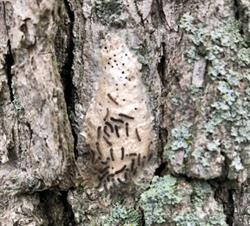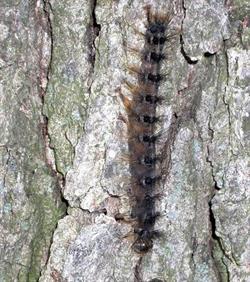Recently in Ann Arbor, residents have begun to notice the effects of a Gypsy moth infestation, which is a common and natural occurrence. The immediate impact is that some trees will lose some of their leaves, which are food for the gypsy moth caterpillars. Gypsy moth infestations are cyclical and it appears the population is nearing the peak of the cycle and should begin to crash. There are natural predators that attack gypsy moth caterpillars, including Nuclear Polyhedrosis Virus (NPV) and Entomophaga maimagia, a type of fungus that can knock down the population. Gypsy moth caterpillars infected by the fungus, which has been spurred by our wet spring/summer, die hanging upside down on the trunk. The dead caterpillars become “mushrooms" and will eventually fall to the base of the tree. They will spread the fungus to next spring's gypsy moth larvae. While the fungus is weather dependent, the virus is not. NPV will build up if there is a high density of Gypsy moth and should cause the population to crash within 3 years. Caterpillars infected by the virus hang from the trunk in an upside “V".
cyclical and it appears the population is nearing the peak of the cycle and should begin to crash. There are natural predators that attack gypsy moth caterpillars, including Nuclear Polyhedrosis Virus (NPV) and Entomophaga maimagia, a type of fungus that can knock down the population. Gypsy moth caterpillars infected by the fungus, which has been spurred by our wet spring/summer, die hanging upside down on the trunk. The dead caterpillars become “mushrooms" and will eventually fall to the base of the tree. They will spread the fungus to next spring's gypsy moth larvae. While the fungus is weather dependent, the virus is not. NPV will build up if there is a high density of Gypsy moth and should cause the population to crash within 3 years. Caterpillars infected by the virus hang from the trunk in an upside “V".
There are a few steps residents can take to help the fungus kill Gypsy moths. If you see caterpillars infected with the fungus, you can collect them, mix them with soil and spread them around other trees to help spread the fungus. When you start to see the egg masses, scrap them off trees and put in a bucket of soapy water. If the egg masses are just scraped off the tree and allowed to fall on the ground, the eggs can still hatch next year.
 Deciduous trees that have been partially or totally defoliated by Gypsy Moth caterpillars, will put out a new set of leaves this summer. During dry periods, trees that have been defoliated, should be watered, at least 1" per week, to help reduce stress and ensure they remain healthy and vigorous.
Deciduous trees that have been partially or totally defoliated by Gypsy Moth caterpillars, will put out a new set of leaves this summer. During dry periods, trees that have been defoliated, should be watered, at least 1" per week, to help reduce stress and ensure they remain healthy and vigorous.
Below are links about Gypsy Moth and ways to manage it. The Michigan State University Extension recommends using a sticky substance (e.g. Tanglefoot) on the bands that are attached around the trunk to trap the larvae and keep them from reaching the leaves (see link on how to create a Gypsy Moth barrier band).
Resources
